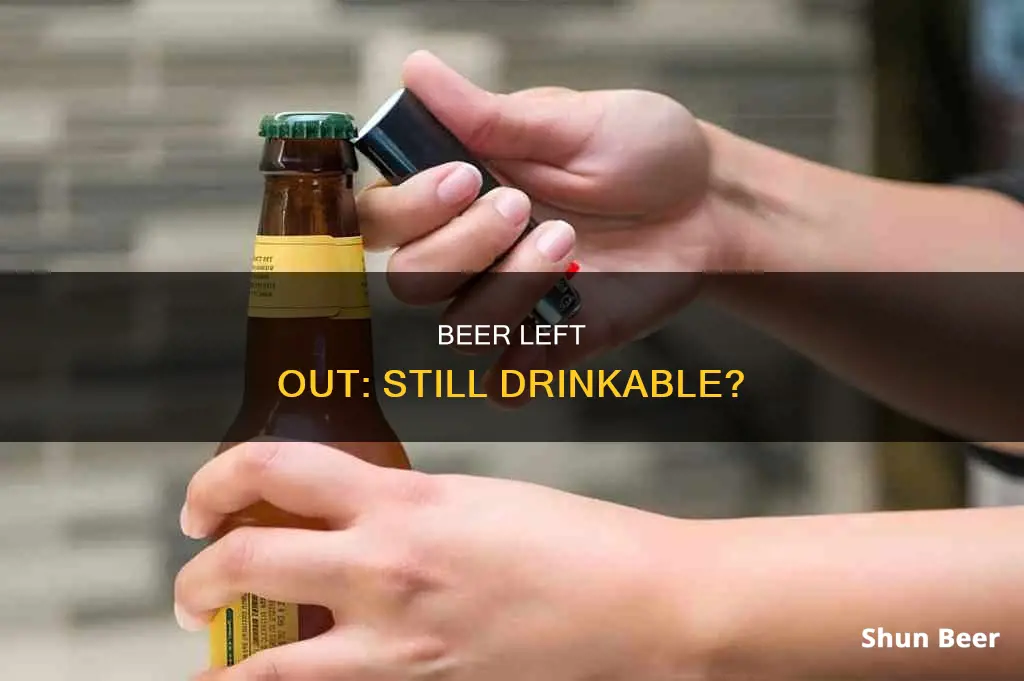
Beer is one of the most unique and easily recognizable drinks in the world. But what happens when you don't finish that freshly popped bottle and leave it out overnight? The short answer is that it depends. While drinking day-old beer will not expose you to health risks, it will definitely impact your drinking experience.
| Characteristics | Values |
|---|---|
| Is it safe to drink? | Yes, it is safe to drink open beer that has been sitting out for a day or two. |
| Taste | The beer will still taste like beer, but there will be a slight drop in taste and flavour. The longer it's left out, the greater the risk of decomposition. |
| Carbonation | The beer will lose its carbonation and become flat. |
| Expiry | Beer does expire, but it does not make it unsafe for consumption. |
| Oxidation | Beer undergoes oxidation when exposed to oxygen, which causes changes in its colour, appearance, aroma and taste. |
| Storage | Store beer in a cool, dry place, away from direct sunlight and at a temperature between 35 and 55 degrees Fahrenheit (2 to 13 degrees Celsius). |
| Refrigeration | Refrigerating an open beer can slow oxidation and preserve its freshness for a little longer. |
| Sealing | Seal bottles or cans tightly after opening to prevent oxygen exposure and slow down spoilage. |
| Temperature Fluctuations | Avoid exposing beer to temperature fluctuations as it can negatively impact its quality and taste. |
| Freezing | Do not freeze and thaw beer as it affects carbonation levels and taste. |
| UV Rays | Exposure to UV rays can cause compounds in beer to break down, leading to a pungent odour. |
| Bacterial Infestation | Bacterial growth is uncommon due to alcohol acting as a preservative, but it can occur and cause the beer to rot. |
What You'll Learn

Beer left open overnight is safe to drink
Beer Left Open Overnight: Is It Safe to Drink?
It's happened to the best of us: you crack open a cold one, but life gets in the way, and before you know it, your beer has been sitting out open overnight. So, is it safe to drink? The short answer is yes. Drinking a beer that has been left open overnight will not likely expose you to any health hazards. However, it's important to note that this depends on the storage conditions and the length of time it was left open.
Factors Affecting Beer's Shelf Life
The shelf life of an open beer can be influenced by various factors, including temperature, sunlight exposure, and oxidation. Beer should be stored at a cool temperature, ideally in a refrigerator, to prolong its freshness. Leaving beer in a warm place or exposing it to direct sunlight can accelerate the deterioration process, making it go flat or stale more quickly.
Oxidation and Taste
When left open, beer undergoes oxidation, which affects its colour, appearance, aroma, and taste. This process starts as soon as the beer is exposed to the air, and the longer it's left out, the more pronounced these changes become. While it may still be safe to drink, the beer will likely lose carbonation and develop an off-flavour, becoming flat and less palatable.
Health Risks
While drinking a beer left open overnight is generally safe, it's important to use your judgement and assess any visible or olfactory signs of spoilage. If the beer has been left in a warm environment or exposed to sunlight, it may be more susceptible to bacterial growth, which can cause an unpleasant taste, cloudy appearance, or strange odour. If you notice any of these signs, it's best to discard the beer to avoid any potential health risks associated with consuming contaminated beverages.
Best Practices
To ensure the best taste and quality, it's recommended to consume an open beer within 24 to 48 hours. If you plan to finish the beer the next day, seal the bottle or can tightly to minimise oxidation and prevent insects or debris from contaminating the beverage. Refrigeration can also help slow down the oxidation process and preserve the beer's freshness for a little longer.
Pregnancy and Beer: Is Dealcoholized Beer Safe?
You may want to see also

It won't taste as good as a freshly opened bottle
It's true that you can drink a beer that's been left open and sitting out without risking your health. However, it's important to note that it won't taste as good as a freshly opened bottle.
When beer is exposed to the air, it starts to oxidize, which affects its colour, appearance, aroma, and taste. This process happens gradually, and you may not notice significant changes if you drink it the next day. However, the longer it's left out, the more pronounced these changes become.
The taste of beer is one of the most unique and easily recognizable among all drinks. When left open, the beer's oxidation process begins, and it starts to lose its distinctive sharp taste. Even if you refrigerate it, the beer will not taste as bubbly or sparkly as a freshly opened bottle.
Additionally, exposure to sunlight will accelerate the breakdown of the beer's taste. The sun's UV rays can cause the compounds in the beer to break down, resulting in a pungent odour and a rapid deterioration of flavour.
While it's safe to drink a beer that's been left open and sitting out, it's important to manage your expectations regarding its taste. The longer it has been left open, the further it deviates from the perfect taste of a freshly opened bottle.
To minimize taste changes, it's recommended to consume an open beer within one to two days. Proper storage, such as sealing the bottle or can and keeping it in a cool, dark place, can also help slow down the oxidation process and preserve the beer's original flavour for a little longer.
Beer and Zoloft: What You Need to Know
You may want to see also

It will lose its carbonation and become flat
When beer is exposed to the atmosphere, it begins to lose its carbonation and become flat. This process is called oxidation, and it starts as soon as a bottle or can of beer is opened. The carbonation in beer contributes to its refreshing feel and unique, sharp taste profile. Therefore, flat beer is dull and stale, with an off-flavor taste.
The oxidation reaction is significant enough to alter the taste and flavor of the beer greatly after about two days. However, you may notice some changes in its taste if you leave it out overnight. The taste will be far from pleasant, and the beer will be flat and lack carbonation.
The good news is that flat beer is still safe to drink. There is little chance of microbial contamination, and you will not be exposing yourself to health hazards. However, the taste will be far from what you would expect, and many would choose to throw it out.
To prevent beer from going flat, it is recommended to drink it completely once opened. If you don't finish the beer, you can try to seal the bottle or can tightly to prevent oxygen exposure, which causes oxidation. Storing beer in a refrigerator will also help slow down the oxidation process and preserve its freshness for a little longer.
Alcohol-Free Beer and Metronidazole: Is It Safe?
You may want to see also

It's best to store beer in a cool, dry place
Beer is best stored in a cool, dry place. This is because temperature plays a pivotal role in determining a beer's shelf life. If stored in a warm place above room temperature, its freshness will decrease quickly. On the other hand, storing it in a refrigerator prolongs its freshness. The ideal temperature for storing beer is between 35 and 55 degrees Fahrenheit (2 to 13 degrees Celsius).
It's also important to keep beer away from light. Exposure to UV rays is one of the fastest ways to ruin your beer, even before its expiry date. That's why beer bottles are typically green or brown—these colours help to minimise the effects of light strike by blocking out certain wavelengths of light. Clear bottles, on the other hand, offer no protection against light strike. So, if you have a refrigerator, always store your beer in it.
In addition to temperature and light, another factor that affects beer's shelf life is oxygen exposure. When oxygen comes into contact with beer, it can cause oxidation, degrading the beverage's flavour and changing its colour. Bottled beer is more susceptible to oxygen exposure than canned beer. To reduce the surface area of beer that is exposed to oxygen, it's recommended to store beer upright rather than on its side.
To summarise, the best way to store beer is in a cool, dry place, away from light, and with the bottles or cans stored upright. This will help to maintain the beer's freshness, flavour, and quality.
Beer and UTI: Is There a Link?
You may want to see also

Exposure to UV rays can cause the compounds in beer to break down
Exposure to UV rays is one of the fastest ways to ensure beer goes bad, even before its expiry date. The sun's rays are notorious for shortening beer's shelf life. They penetrate the bottles and trigger a chemical reaction that breaks down its taste components, causing flavour deterioration.
When exposed to UV rays, the alpha acids in hops break down and react with sulphur, forming a chemical compound called 3-methylbut-2-ene-1-thiol or 3-MBT. This compound is chemically similar to one found in spray produced by skunks against predators, giving the beer a distinct skunky aroma and flavour.
The process of skunking can occur even in low levels of light, such as the light from a refrigerator or a store shelf. It can also happen in brown bottles, although the darker colour helps protect the beer to some extent. To prevent this, beer should be stored in a cool, dark place, such as a cellar, pantry or dedicated beer fridge, and away from direct sunlight.
The effects of UV exposure are more prominent in beers like India Pale Ales and other light beers, which are best consumed within three months of packaging. Craft varieties such as IPAs, Pale Ales, Kolsch and Amber also experience degradation due to light if not stored properly in dark places.
In addition to UV rays, oxygen exposure is another significant factor that affects beer's shelf life and quality. When oxygen comes into contact with beer, it can cause oxidation, degrading the beverage's flavour and changing its colour. Bottled beer is more susceptible to oxygen exposure compared to canned beer.
Beer and Diabetes: What Diabetics Need to Know
You may want to see also
Frequently asked questions
Beer that has been opened for a few days will not taste as good as fresh beer, but it is still drinkable and unlikely to make you sick. Beer has a shelf life of around two days before it loses its flavour significantly. Beer that has been sitting out for more than a week should be avoided due to the risk of bacterial contamination.
Spoiled beer will have an unusual smell, such as skunk or urine, or an off taste, such as metallic, sour, or cardboard-like flavours. It may also appear cloudy or have sediment at the bottom of the bottle. These signs indicate bacterial contamination or extended exposure to oxygen.
To extend the shelf life of an open beer, store it in a cool, dry place, ideally in the refrigerator, and keep it away from light. Ensure the bottle or can is sealed tightly to prevent oxygen exposure, and store it upright to minimise the surface area exposed to oxygen.







